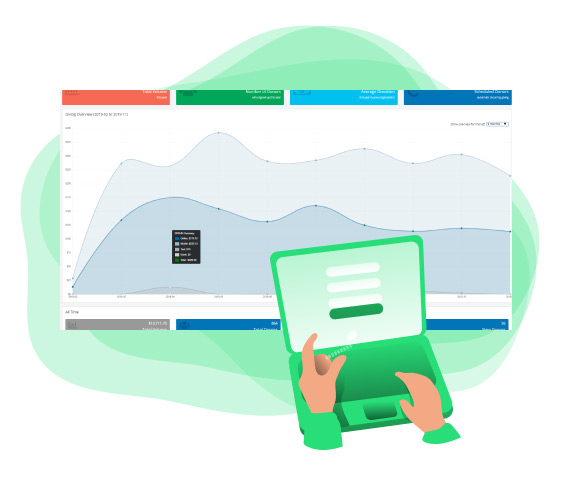
The Ultimate Guide to Online Forms for Churches
Though technology keeps advancing, there are some people who still enjoy filling out paper forms to register for a church event, and some church staff don’t mind taking the time to enter that information into a computer or filing it away in a dusty cabinet.
However, as a church leader, you may be frustrated with losing those hard copies or having to manually input duplicate information that takes up more time than you probably have. Technology can make your administrative life easier by coordinating processes and simplifying tasks.
When it comes to forms, online giving and registration forms are a great way to instantly collect donations, sign up for events, and obtain volunteers. Remove the stress of event planning and receive payments or donations by going paperless. (Don’t forget all the trees that will be saved, too!)
Digital forms can be used to gather information or data and allow people to register and pay for classes or events. Plus, with an integrated church management system, the information and money received through the forms is seamlessly incorporated with your other church software—saving your staff valuable time.
This post will discuss what online forms are and why your church should implement them. We’ll also talk about the multiple purposes, features, and best practices to help you get the most out of your online form builder.
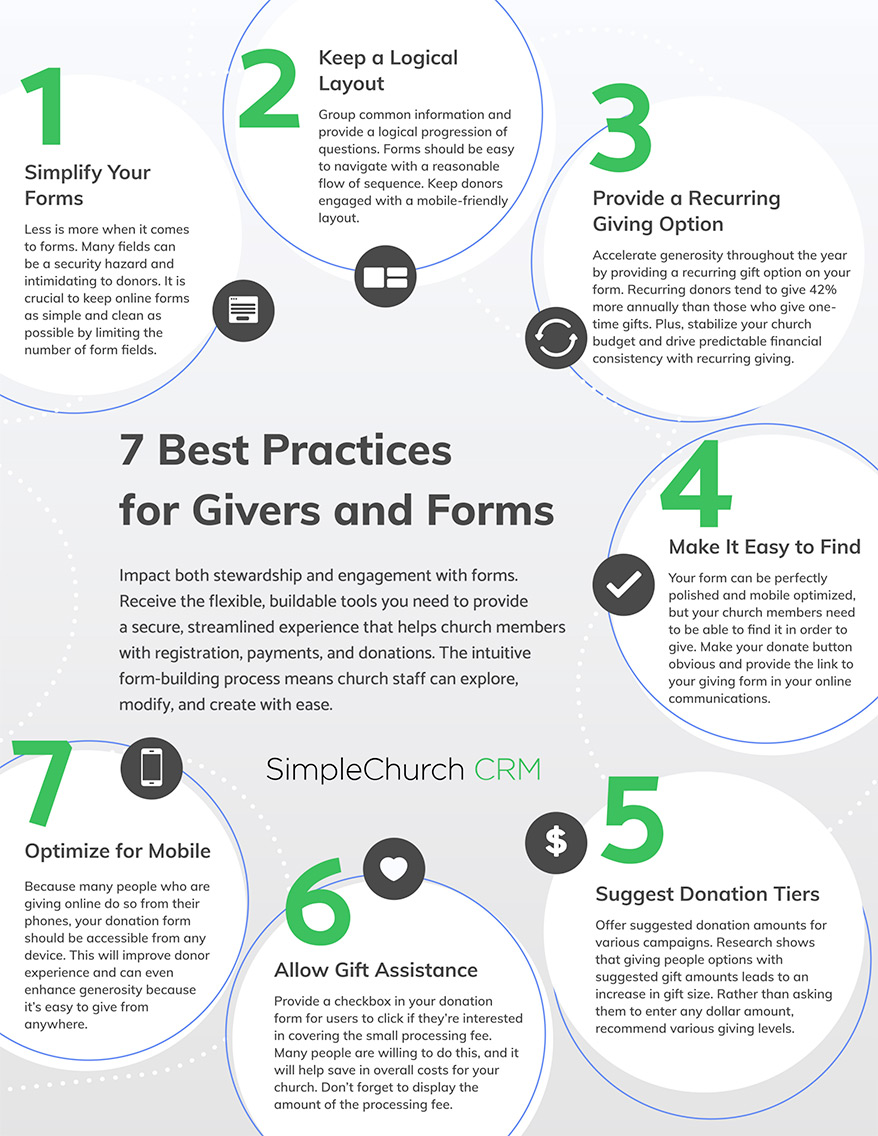
What are online forms?
An online form is a group of fields that a person will input data or information into. It’s then electronically submitted to your church. These forms can be completed online from a computer, tablet, or smartphone.
The form fields include a range of options, from an open text box to a button to a dropdown menu. It’s similar to a paper form in that it collects information from the user, but it saves time and hassle because your team won’t have to transfer the answers because it’s done automatically!
There are many different reasons why digital forms are useful for churches. We will get into further detail below, but generally, digital forms are desirable for collecting donations, payments, and information. They also allow people to conveniently register for classes, events, or volunteer opportunities.
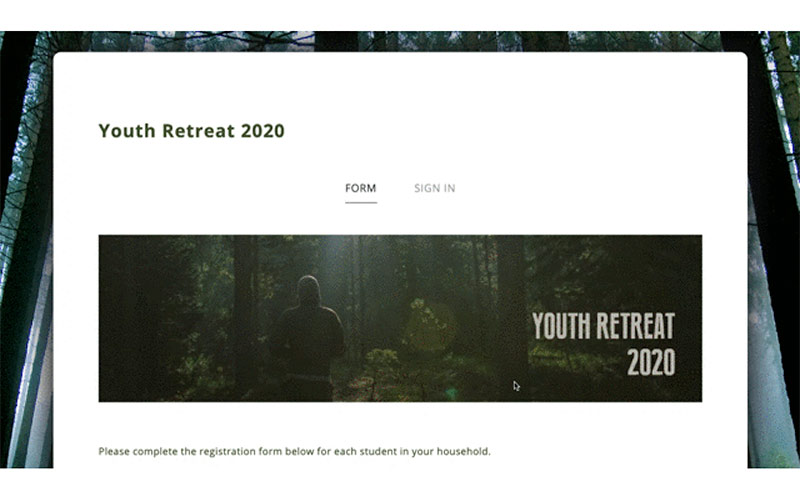
Why should your church use an online form builder?
Digital forms are easy to use, and they are also a great tool to help ministry run smoothly. They are beneficial because of their versatility, simplicity, and automation.
Versatility
You can build as many forms as you’d like, but most churches aren’t getting the most out of their form builder because they’re only creating one or two forms. But with SimpleChurch CRM, you can create an unlimited number of forms for just about anything! Not only can you collect tithes and offerings online, you can use forms to collect new guest info and allow people to register for events or submit prayer requests - and that's just a starting point! They provide flexibility because you can also use forms for surveys, sign-ups, facility rentals, and of course, donations. So, get creative and start building more forms to engage your congregation.
Simplicity
The form builder is simple to use—with templates, various customizations, and drag and drop options. You can use a single form tool for all areas of ministry, from signing up new families in kids church to registering volunteers for the next outreach event. Easily share every form on your church website or via email, text message, social media, and your mobile app. Plus, every submission can be automatically emailed to applicable staff members and is saved within your integrated church management software.
Automation
Engage your community and save time by using workflows. Form submissions can trigger communication like a text or email. They can assign a follow-up task to a team member. Answers to a form can add an important note to a profile. Automation can help establish consistency and member care, making sure that no attendees fall through the cracks.
Various Uses of Online Forms
When we said that digital forms could be used for multiple things, we meant it! Below are just five ideas to help get you started with your online form builder.
-
Event Registration
Church and community members can register for the events that your church is hosting. You can set up a limited capacity, too, so people won’t be able to register once the event is full. Automatically send confirmation emails after people have signed up and use that for ticketing proof. If your event requires a fee, a payment button can be included directly in the event form.
-
Giving
Within your online giving platform, a donation form makes it easy for donors to give, thus increasing generosity. Embed a digital giving form on your church website so, people can easily give their tithes or offerings. Create a special form or designated fund to raise money for special projects, mission trips, year-end giving, or disaster relief. Whether attendees are sitting in service or watching online, they can donate on your website, via text, or in your church app simply by filling out your digital giving form.
-
Volunteer Registration
Now you won’t have to worry about tracking down volunteers or remembering who is serving where. Forms create an easy solution for volunteers to sign up for various opportunities. Recruit new help, coordinate times, and communicate with all your volunteers. In the form builder, ask for as much information as you need, such as the volunteer’s availability to serve at a specific event or service. Utilize workflows based on form submission, which allow for immediate email or text communication and assigned interactions.
-
Contact Forms
When a new visitor attends your church, have them fill out a digital connection card. Save administrative time by having current members update their own contact information through an online contact form. You can include multiple sections aside from contact info, like prayer requests and next step opportunities that attendees might be interested in. Once the form is submitted, it can be emailed to the corresponding leader so they can follow up.
-
Religious Education Classes or Tuition Payment
Forms can also be used to allow churchgoers to sign up and pay for religious education classes. People can also pay for tuition for private education. If you have SimpleChurch Giving integrated with your church management software, your forms will automatically connect to your member records and keep everything updated—saving your administrators time because they won’t have to enter duplicate information.
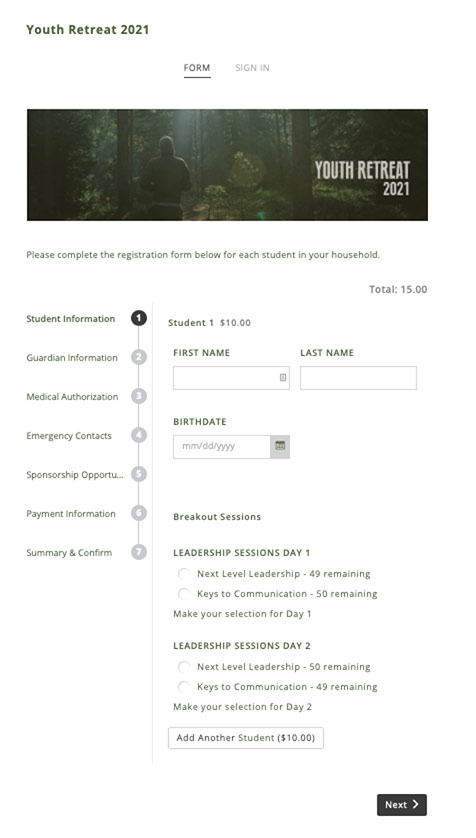
Features of Forms
There are many benefits to utilizing online forms for your church. Below are some powerful, timesaving features you may not know about that can simplify the process for both admins and users, creating an increase in attendance and donations.
Produce Unique Tickets for Events
Need tickets to keep track of people entering your event? Ticketing is fast, easy, and an included feature in SimpleChurch forms. If enabled, registrants will receive their tickets via their confirmation email. Each will include a unique QR Code for easy check-in. They can print their confirmation code or simply bring their smart phone to the event. In the case that a ticket is misplaced, managers will also have access to ticket information in your comprehensive Form Responses.
Customize Payment Options
Forms give you multiple payment options. Allow people to donate or pay with credit cards, debit cards, or electronic checks. There is also a “pay later” option you can enable for those registrants who prefer to pay with cash or check. There are multiple Payment Fields as well, that are used to collect payments differently depending on the goal of your form. Amount buttons, for example, are ideal for sponsorships or suggested amounts and contain specific dollar amounts on each button. The “user amount” field allows the giver to determine the amount they'd like to give. There are also per-item payment fields that allow you to price items and track inventory—ideal for selling church merch like books or t-shirts.
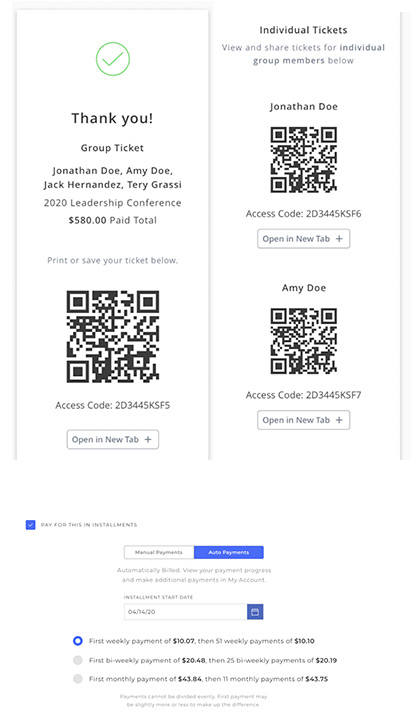
Create Responsive Forms
Conditional formatting and steps allow you to adjust your form to only show a few fields at a time and only if they're applicable. For example, if the first question they respond to is yes or no, the form would populate another question based on the chosen answer. Essentially, you have the option to "hide" any questions that aren't applicable based on the very first and only visible question. Multi-step forms increase the likelihood that your form will be completed up to 300% because those using your form aren't initially overwhelmed with a form full of questions.
Sign-Up Slots
If you need volunteers for different services, events, or you church is hosting a potluck, Sign-Up Slots are a great feature to use. In the forms management system, you can use this element to give people an easy way to register to serve. The form will collect the volunteer’s contact info, allow them to choose which area they prefer to serve, and provide them with all the event information.
Essentially, there will be several available “spots” to sign up for—whether it’s to be a greeter during a weekend service or to bring potatoes to the next potluck. As people sign up for a particular slot, the number of available spots will decrease on the form.

Forms Best Practices
Though you might already be implementing online forms at your church, there are some things that people do to create overly complicated or overwhelming forms. Below are some best practices to enhance your forms and may help encourage more people to fill them out.
-
Simplify Your Forms
When it comes to forms, less is better than more. A large number of fields can possibly create security issues, and they’re often intimidating to donors. It is important to keep online forms simple and clean by using the least amount of form fields as possible. Create forms with no more than one column. Consider using conditional formatting or multi-step fields, too, so questions only populate once a response has been provided
-
Keep a Logical Layout
Provide a logical progression of questions and keep common information grouped together. Forms should be easy to navigate with a reasonable flow of sequence. For example, don’t ask for somebody’s phone number before they give their name. To make forms less daunting and overwhelming, group questions into sections to help break up the form. Provide headers for the various sections, like “Contact Information” or “Personal Information.”
-
Provide a Recurring Giving Option
Increase generosity throughout the year by providing a recurring gift option on your online giving form. Recurring donors tend to give 42% more annually than those who give monetary gifts one at a time. You can even stabilize your church budget and drive predictable financial consistency because of recurring giving. You will be able to better supplement dips in giving because recurring gifts provide a better idea of what can be expected financially.
-
Optimize for Mobile
Having a mobile-friendly layout on your form will help keep donors engaged. The majority of people use their smart phones to input information, register for events, or contribute financially, so making your forms accessible from any device is a good idea. Mobile optimization will improve your donor experience and can even enhance generosity because it’s easy to give from anywhere.
-
Make the Form Easy to Find
Your form can be perfectly polished and mobile optimized, but people need to be able to find it so they can give or sign up. Make clear and obvious call-to-action buttons and provide direct links to your forms in your online communications. The last thing you want to happen is for people to miss out on the opportunity to give because they couldn’t find where to donate or for your event to have very few attendees because they didn’t know where to register.
-
Suggest Donation Tiers
Offer suggested donation amounts for different campaigns. Research shows that providing people options with suggested gift amounts leads to an increase in gift size. That’s because more people will be inclined to give if they know what the goal is. Rather than asking donors to enter any dollar amount they want, recommend various giving levels. For example, a gift of $20 will provide a certain number of supplies for a project, $50 will feed a family, etc.
-
Allow Gift Assistance
Provide a checkbox in your donation form for users to click if they’re interested in covering the small processing fee. Often, people are not even aware that churches must pay processing fees in order to accept electronic payments or donations. Even more so, donors and registrants don’t know they have the option to help cover that fee. When givers or registrants become aware of the processing fee, and the option to assist in covering it, they're happy to help! It will also assist in saving overall costs for your church.
-
Embed on Website
You can quickly create embeddable forms directly on your church website. This will allow your organization to collect donations straight from your site without having to click multiple links or leave your page. The fewer times donors must click to reach your giving form, the more likely they will decide to contribute. On the other hand, you could lose donations if they have to click multiple times or visit more than one page just to give.
-
Create a Branded Form
A generic online giving form can dissuade people from giving. That’s because people are more apprehensive to provide their financial information to an unfamiliar source. When a donor lands on a branded donation page, they’re more likely to give and give generously. So, make your digital donation form consistent with your church branding—customize the color scheme, messaging, and logos to match your church.
Incorporating Forms at Your Church
Accomplish more with your church software by capitalizing on custom, online forms. SimpleChurch CRM is here to support your church’s mission and serve your needs.
If you’re ready to leverage the power of SimpleChurch’s online forms, contact us today to get started for free!
Church Management Software to Meet Your Ministry Goals
Increase efficiency for your teams with powerful technology that will put more time back their day, so your church can focus on ministry. With whole-church management at your fingertips, you can grow your impact, regardless if your church is just starting out or you have a large, multi-campus megachurch.
With an integrated ChMS, you’ll have access to a suite of tools that will save you time, organize your people, and streamline your processes. Contact us today to get started or begin your free 30-day trial now!
